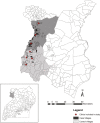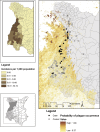Assessing human risk of exposure to plague bacteria in northwestern Uganda based on remotely sensed predictors
- PMID: 20439974
- PMCID: PMC2861378
- DOI: 10.4269/ajtmh.2010.09-0737
Assessing human risk of exposure to plague bacteria in northwestern Uganda based on remotely sensed predictors
Abstract
Plague, a life-threatening flea-borne zoonosis caused by Yersinia pestis, has most commonly been reported from eastern Africa and Madagascar in recent decades. In these regions and elsewhere, prevention and control efforts are typically targeted at fine spatial scales, yet risk maps for the disease are often presented at coarse spatial resolutions that are of limited value in allocating scarce prevention and control resources. In our study, we sought to identify sub-village level remotely sensed correlates of elevated risk of human exposure to plague bacteria and to project the model across the plague-endemic West Nile region of Uganda and into neighboring regions of the Democratic Republic of Congo. Our model yielded an overall accuracy of 81%, with sensitivities and specificities of 89% and 71%, respectively. Risk was higher above 1,300 meters than below, and the remotely sensed covariates that were included in the model implied that localities that are wetter, with less vegetative growth and more bare soil during the dry month of January (when agricultural plots are typically fallow) pose an increased risk of plague case occurrence. Our results suggest that environmental and landscape features play a large part in classifying an area as ecologically conducive to plague activity. However, it is clear that future studies aimed at identifying behavioral and fine-scale ecological risk factors in the West Nile region are required to fully assess the risk of human exposure to Y. pestis.
Figures


References
-
- Poland JD, Dennis DT. In: Plague Manual: Epidemiology, Distribution, Surveillance and Control. Dennis DT, Gage KL, Gratz N, Poland JD, Tikhomirov E, editors. Geneva: World Health Organization; 1999. pp. 43–54. (Diagnosis and clinical manifestations).
-
- Campbell GL, Dennis DT. In: Harrison's Principles of Internal Medicine. Fauci AS, Braunwald E, Isselbacher KJ, Wilson JD, Martin JB, Kasper DL, Hauser SL, Longo DL, Harrison TR, editors. New York: McGraw-Hill; 1998. pp. 975–980. (Plague and other Yersinia infections).
-
- Butler T. In: Current Topics in Infectious Disease. Greenough WB, Merigan TC, editors. New York: Plenum; 1983. pp. 71–92. (Plague and other Yersinia infections).
-
- Dennis DT, Gage KL. In: Infectious Diseases. Cohen J, Powderly WG, editors. London: Mosby; 2003. pp. 1641–1648. (Plague).
-
- Dennis DT, Meier FA. In: Pathology of Emerging Infections. Horsburgh CR, Nelson AM, editors. Washington, DC: American Society for Microbiology Press; 1997. pp. 21–48. (Plague).
MeSH terms
LinkOut - more resources
Full Text Sources
Medical

